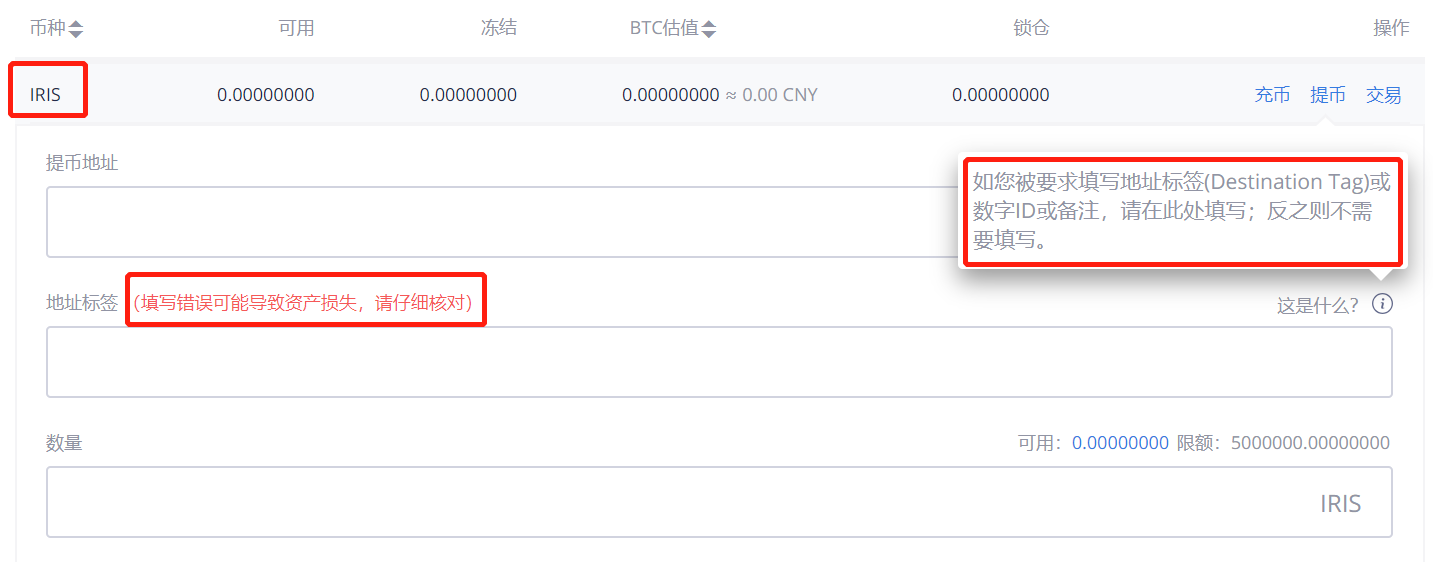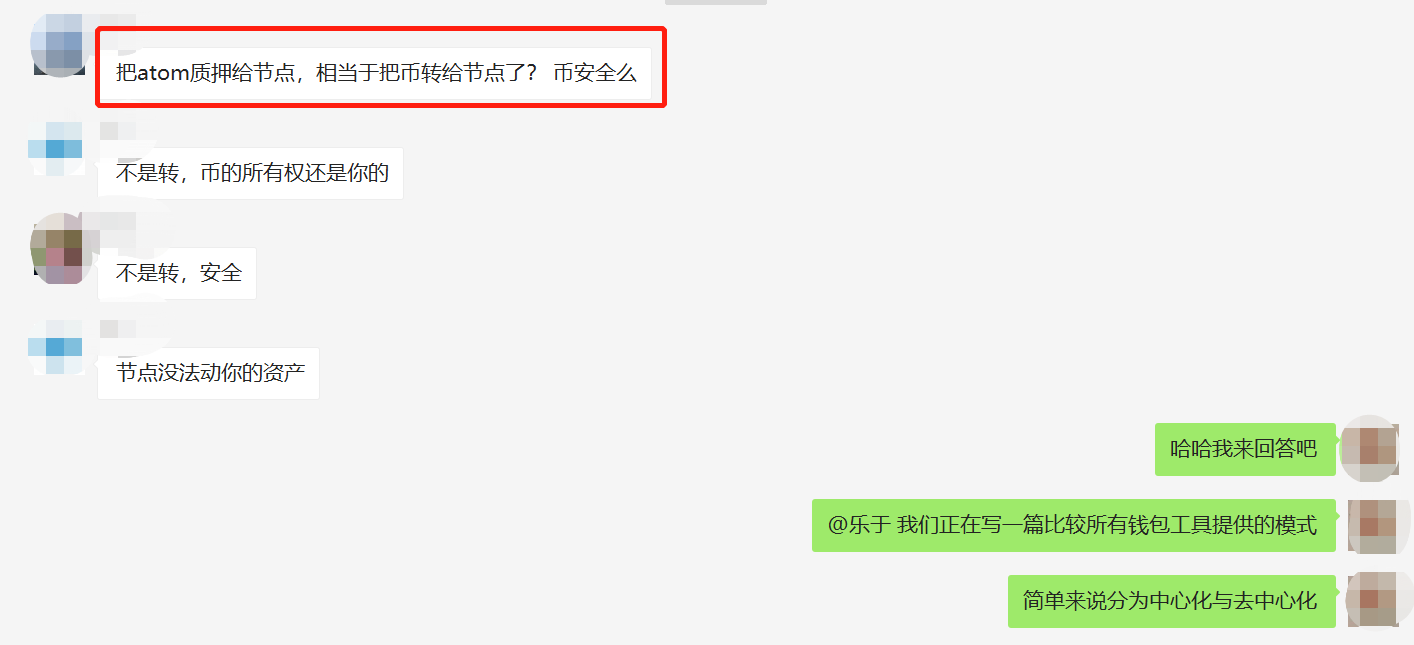Comparison of the advantages and disadvantages of the Staking revenue generation tool
Staking fires, the star projects Atom and IRISnet start trading, you buy coins but doubts where to put the proceeds? Which platform is more fair and transparent? This article is to help you solve the problem~
Before starting, I want to sort out some problems for most of the money holders.
From the feedback from the community, we found that when some coins belonging to the PoS consensus are raised, the coin or other exchanges will be required to fill in the address tag (memo). Many users do not know how to fill in, because not Don't hesitate to operate the money to the wallet to generate revenue. Let's take a look at the sample map of the fire coin below.

Many people buy IRIS or Atom on the coin, and they want to raise the money to the wallet to generate revenue. The wallet that the user wants to mention does not provide the user address label (memo). If the user question is not filled, it will not lead me. I can't get it.
- Why did the Sino-US trade war have a stock market crash and bitcoin strengthened?
- The Ministry of Public Security named the fake project "BRIC Digital Currency" and carefully covered the pyramidal chain MLM project!
- Twitter Featured: Coin An Zhao Changpeng sued Sequoia for damage to his reputation
The answer is that if you are a decentralized wallet such as Wetez or imToken, you will not be asked to fill it out. Even if you fill it out, the currency will be received (see the red box on the right side of the coin). If you don't ask, you don't need to fill it out.
PS: If you extract a centralized wallet or exchange, the wallet itself will give you an address label, please be sure to fill it out, why? Because a centralized wallet or exchange will not create a personal wallet address for you, use a common address plus an address tag to identify the user account.
Solving the problem of raising coins, we then look at which tool to generate revenue, the advantages and disadvantages of these tools are compared
Let’s look at the most frequently asked questions about the staking benefits in the community. Real cases don’t just happen together.

The user's doubts: Is the Atom pledge to the node equivalent to transferring the coin to the node, how can security be guaranteed?
The staking of Atom to the node is a chain of entrusted actions. In fact, the ownership of Atom is the same in the user's personal address. The change is that the user transfers the PoS mining power to the node, and the node generates revenue on behalf of the user.
The tools that generate revenue are divided into a centralized model and a decentralized model . Next we will discuss the differences between the two.
A simple understanding of the decentralization model: just like using a centralized exchange, the user believes in the chain itself (mathematical code), the user retains ownership of his own assets (users have their own public and private keys), you can choose yourself PoS mining or commissioning a third-party team for PoS mining.
Decentralized mode is used to commission PoS mining. The user still has the “ownership” of the coin. The difference is that the “authority” of the coin is given to the node (third-party team), and the node generates the revenue and then the node. Or assigned to the user on the chain.
A simple understanding of the centralization model:
Just as it is usually traded on a centralized exchange, the user gives the coin to the centralization organization through trust, and the centralization agency gives the user a proof that the asset is here.
Using the centralized mode for PoS mining (or generating Staking benefits), the user gives the “ownership” and “delegation rights” of the coin to the centralized organization, which is then distributed to the user by the centralization agency.
Answer the above picture problem, choose the centralized method, the security guarantee is to believe the central organization, choose the decentralization method, the security is whether you have protected the private key, the ownership of the currency will not go to the node team because of the "pledge" .
Start the text below to analyze different wallet modes
If you want to have a transparent disclosure, the model that can be checked on the income chain, it is recommended to choose the decentralized mode.
The classification of decentralization mode has the following
Official application
Each chain team will develop at least one wallet to support its own blockchain storage and delivery. After the PoS has staking function, the official team's wallet will also support it, but in general the official team's wallet is a web-side wallet ( Desktop side), and only supports English, not so friendly to Chinese users.
2. Wetez Wetez is the first decentralized wallet specially designed for PoS. It is also the mobile wallet that currently accesses the most PoS projects. Currently, it supports well-known PoS public chains such as Tezos, Cosmos and IRISnet. The subsequent access plans include Loom and Wanchain. IoTex and so on.
Imtoken
Imtoken is a very early and well-known Ethereum wallet. The only PoS project currently supported is Cosmos (Cosmos is also the fourth public chain supported by imToken). The overall interface design is quite good. You can continue to pay attention to whether the subsequent imToken cuts into multiple PoS projects. The Staking Ecology.
Trust wallet
Trust wallet has been acquired by the currency security, and it is one of the currency security strategic plans. Recently, Trust Wallet has already supported the storage of Tezos. It is also mentioned in the announcement that Q2 will support Tezos' Staking business.
In addition, Trust Wallet also supports Callisto, TomoChain, IoTex, Spank, etc. through the web-side mode. However, according to the test results, only Callisto and IoTex support are slightly friendly, and other basics cannot be used.
Summary of decentralization mode
advantage
– Users have ownership of their own assets
– Can choose any certifier node instead of a single team
– All reward distributions are available on the chain and the fees are transparent
Disadvantage
– Users need to keep their private keys safe and need to understand the cost
If you want a more intuitive operation and don't want to record as many public and private key pairs, you can use the centralized mode (PS: but there is a risk of a centralized platform for evil and opacity).
The classification of the centralized mode has the following
1. Firecoin Mine Pool The Firecoin Mine Pool currently supports the lock silos of PoS and DpoS of Cosmos, IRISnet, EOS, TRON, IOST, ONT and CMT.
Let's look at the current lock-up of the popular project, Cosmos and IRISnet, to participate in the Cosmos lock warehouse to mine at least 100 Atom.
Participate in IRISnet lock mining to mine at least 1000 IRIS
If you do not meet the above criteria, you are advised to use other tools.
The calculation income of the fire coin pool is quite special. It is not the user Staking which currency will get the token income. The following is a brief description. The fire coin pool consists of three elements, PoW calculation mining, PoS lock warehouse mining, and Vote for mining, in accordance with any of the above three elements can get platform power (HPOW), and obtain HPT according to the ratio of computing power, and finally get the "community reward pool" income according to the proportion of all HPT



You can see the above three examples, the fire coin pool will tell you the estimated HPT income, and finally rely on HPT to reward
User's income has two parts
1. The value of HPT tokens
2. Reward in the community reward pool based on HPT (the community reward pool comes from the reward of the fire money PoS lock warehouse mining and the reward of DPoS because of voting on the node and the rewards provided by the project party)
If you are a PoS holder, you are actually getting the rewards of the above two. Please pay attention to the community reward pool not only yourself but also PoW computing providers, HPT holders, etc. The common denominator reward is mainly the income generated by the PoS currency.
This is a very complicated and fuzzy income model, which is difficult to calculate and compare. The user's income is based on the HPT token value and the distribution principle of the community reward pool and the fire coin team.
It is recommended that friends like simple and simply do not choose the fire coin pool, and this fuzzy mode has platform operation space.
2. Hashquark
Hashquark is a sub-brand of Wanxiang Hashkey, responsible for mining PoS and DPoS
At present, the desktop and Hashkey Hub mobiles provide Atom, IRIS, QTUM, VET, EOS, CYB, VTHO deposit mining, which does not provide the PoS mining commission rate, but directly tells the user the actual reward

We query the data on the chain, the commission rate is 10% in both Atom and IRIS.
Advantages: stable technical service (behind Wanxiang Group)
Disadvantages: the need to identify the identity of the currency is cumbersome, the user does not have multiple nodes to choose
Cobo wallet
Cobo wallet was developed by the team led by the fish pond co-founder Colorful Angelfish
Currently PoS mining includes LBTC, DASH, XZC, VET, VSYS, IOST, DCR
There are some thresholds for voting, but not too high, almost all retail investors can participate.
Future will support Cosmos, IoTex, Loom, Tezos
Advantages: technical service is stable (behind the fish pond past technology accumulation)
Disadvantages: users do not have multi-node delegation options
Summary of centralization commissioning tools
advantage
– Easy to operate and intuitive
– Users do not need to back up their private keys, and losing is a risk
– There will be more operational incentives to participate
Disadvantage
– Only one node can be selected (that is, the tool provider)
– The platform is at risk (such as untimely payment, changing rules, and changing commission rates)
neutral
– The ownership of the coin is given to the wallet
A deeper understanding of decentralization tools
The decentralized wallet is divided into a web-side wallet and a client-side wallet. The security level of the two is not the same. A simple method of judging, if the next page is like a click-through jump, belongs to the webpage.
For the security of the decentralized wallet, the most important thing is the security of the private key. The webpage wallet stores the private key in the browser cache. When it needs to be signed, it is used for signature. The client wallet stores the private key. In the local environment of the user's mobile phone, the direct comparison of the two clients is relatively safe, and the webpage wallet is more likely to be attacked by the phishing website.
Seeing this, I believe that you can decide which wallet and tools you want to use. Those who are accustomed to centralization can find their own centralized wallet. Friends who like to have their own assets and operational control can choose one. Decentralized wallet.
We will continue to update Blocking; if you have any questions or suggestions, please contact us!
Was this article helpful?
93 out of 132 found this helpful
Related articles
- Unique BBFT consensus algorithm, Bystack creates a hundred times EOS level TPS high performance blockchain
- DeFi Outlook: The future of the "code world" dominates?
- The transaction costs on the Bitcoin chain are too high for cross-border payments? Listen to the voices from developing countries
- The representative of the twelve constellations of the coin circle – who is the most profitable person?
- Starting from Ruibo: A company that relies on its own disk for a living
- Not only bitcoin! Twitter CEO who is scheduled to invest $10,000 a week in Bitcoin is incorporating more cryptocurrencies into its payment business Square
- Baidu senior R & D engineers reveal the super chain of 6 core technologies | Babbit College Open Course Live Record






